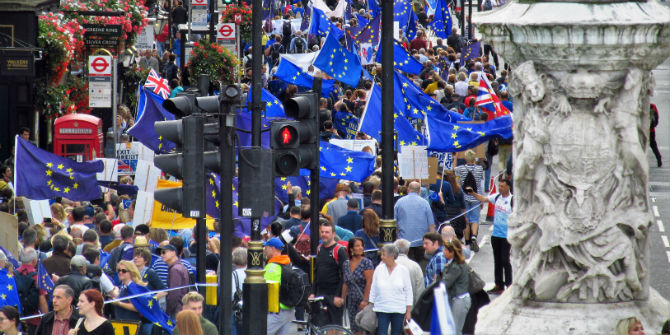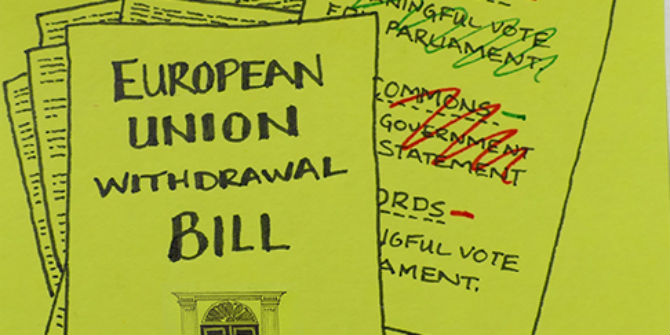
 How does the European Union shape and hone its identity? Odelia Oshri and Shaul Shenhav (Hebrew University of Jerusalem) decipher the ways in which the EU’s discourse on values has changed throughout the 60 years of integration. They show that two values dominated the Union’s treaty texts – ‘democracy’ and ‘market economy’. However, since the 1990s, new values have penetrated the discourse. These new values have served to legitimate the expansion of the EU’s scope and ambition.
How does the European Union shape and hone its identity? Odelia Oshri and Shaul Shenhav (Hebrew University of Jerusalem) decipher the ways in which the EU’s discourse on values has changed throughout the 60 years of integration. They show that two values dominated the Union’s treaty texts – ‘democracy’ and ‘market economy’. However, since the 1990s, new values have penetrated the discourse. These new values have served to legitimate the expansion of the EU’s scope and ambition.
As the EU has grown in size and scope over the past decades, European integration has become less uniform in its nature.Some countries have effectively opted out of the ‘ever-closer union’, deciding not to join the Schengen area or the euro. Notions such as ‘multi-speed Europe’, ‘variable geometry’ and ‘Europe a la carte’ have long shaped scholarly and political discourses. They refer to the phenomenon of policy differentiation, or more specifically, of opting out.
There has been a considerable amount of research into the policy differentiation this involves. Much rarer has been analysis of the value differentiation. This relative silence is puzzling, as three decades ago, in the mid-1980s, the European community had already declared its intention to integrate new norms and values of the ‘normative power’ kind. These values were ‘social justice’, ‘peace’, ‘human rights’ and ‘European identity’.

But introducing and implementing change to the core values of the EU had the potential to undermine its traditional objective of ‘speaking with one voice’ – and consequently, of destabilising the Union. Given recent developments like Brexit and shifts in the EU’s discourse, this organisational dilemma has a new pertinence. Has the EU eventually integrated these new values into its treaty texts – and if so, how? What has changed in terms of the EU’s capacity to adapt to changing times, if anything?
New values have indeed penetrated the EU’s treaty discourse during the various stages of integration. Clearly, starting close to zero in the Lisbon Treaty, the organisational ‘talk’ about new values adds up to 30 percent of the total ‘talk’ on values (see left-hand panel in the figure). Specifically, among the discourse on new values, ‘talk’ about ‘peace’ and ‘human rights’ has grown over the years of integration.
We examined the relationship among entities (which can be understood as the “actors” or “characters”) and values in the text. To do this, we calculated the proximities between values and entities in the Union’s treaty texts with the premise that values that tend to appear ‘together’ with entities relate to and project onto them. While ‘democracy’ and market economy’ are near the EU entity in the text, new values are close to other entities: ‘peace’ tends to appear discursively closer to the member states of the EU, but it also tends to be mentioned alongside entities beyond the EU and the EU itself. Similarly, while the values of ‘human rights’ and ‘European identity’ appear nearer citizens, ‘social justice’ is located closer to European regions.

This strategy enables the EU’s discourse to integrate new values, but positions them at a “safe distance” from the EU as a textual entity – thus distinguishing between the established and the new values. It presupposes a mechanism that mediates between two opposing forces: change and continuity. Honing in on the EU entity in the text, one would be tempted to deduce that the EU’s identity is stable, as throughout the Union’s treaty texts it is constantly associated with ‘democracy’ and ‘market economy’. However, if we zoom out from the EU entity, it is possible to identify and trace the textual change in which new norms and values have indeed penetrated Europe’s normative identity.
The changing landscape of expectations and pressures has shaped the trajectories of each EU treaty. The Union seems to constantly (re-)construct its character through a set of norms and values that posit and mark it as an emerging political entity with new, updated and reframed values. Yet, at the same time, the EU maintains its domestic values of ‘market economy’ and ‘democracy’ in spite of – or perhaps in harmony with – change. As it builds and refines its ethos, the Union – as a ‘speaking subject’ – hones its image as a prudent shaper and reshaper of values and identity frontiers.
This post represents the views of the authors and not those of the Brexit blog, nor the LSE. It first appeared at Democratic Audit.
Dr Odelia Oshri is a lecturer at the European Forum and Political Science at the Hebrew University of Jerusalem.
Shaul R Shenhav is an associate professor at the Department of Political Science, the Hebrew University of Jerusalem.






